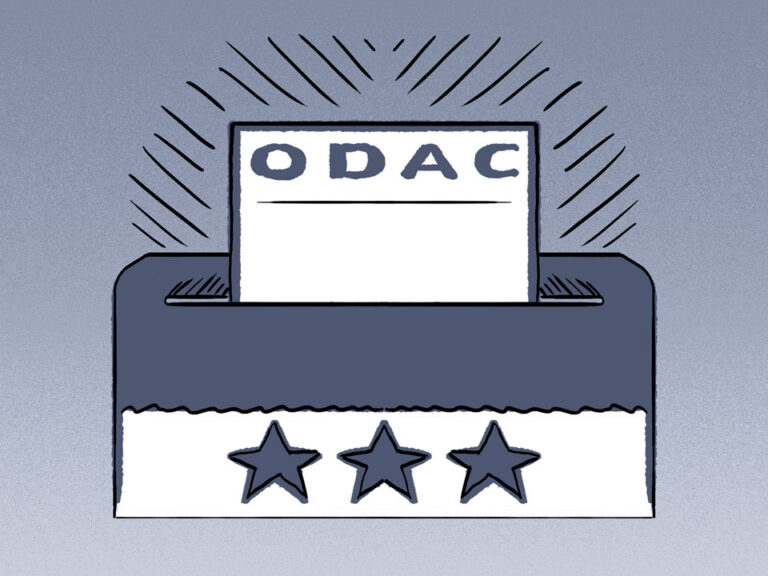On Oct. 5, the FDA Oncologic Drugs Advisory Committee will meet to consider full approval of the supplemental new drug application for Amgen’s agent Lumakras (sotorasib), based on the CodeBreak 200 study.
As I look at the announcement, I see no mention of CodeBreak 201, a 170 patient randomized phase II study of the labeled dose of sotorasib, 960 mg qd, as compared to a 75% lower dose, 240 mg qd. This study, first announced by Amgen on April 28, 2021, was mandated by FDA as part of the accelerated approval of sotorasib in May 2021, with a requirement to complete the trial by October 2022, and submit a final report to FDA by February 2023. The study has been of high importance to the FDA Oncology Center of Excellence and was highlighted in an October 2021 publication in the New England Journal of Medicine.
I am often consulted by colleagues (both formally and informally) as to the optimal dosing of drugs. If asked about sotorasib, I reply that I would not prescribe the labeled 960 mg dose of sotorasib outside of a clinical trial, and that the optimal dose is probably 120-240 mg daily, but that the CodeBreak 201 data should be available soon to provide greater clarity.
Amgen is seeking approval of sotorasib for the treatment of adult patients with KRAS G12C mutated locally advanced or metastatic non-small cell lung cancer, as determined by an FDA approved test, who have received at least one prior systemic therapy.
Meanwhile, prescribers should wonder “What is the optimal dose of sotorasib?”
With CodeBreak 201 data hidden behind the screen, I don’t have a definitive answer—and neither do any of my colleagues who prescribe this drug under an accelerated approval.
Dosage is of crucial importance—to avoid unnecessary toxicity, as well as avoid suboptimal efficacy. If Amgen has completed the dose optimization study as required by FDA, why hasn’t the company published the results or presented them at ASCO, or AACR, or another scientific meeting?
I find these questions baffling.
I have no inside knowledge and no sources within Amgen. However, it seems that the company has the data we all need.
I say this because on Nov. 3, 2022, Amgen held its Q3 2022 earnings call, during which David Reese, Amgen’s executive vice president of research and development, answered an analyst question about the CodeBreak 201 study, stating:
Yes. Thanks, Evan. Look, we understand there’s a lot of interest in the dose comparison data. We’re just getting the top-line results to the FDA and other regulatory authorities. So, it’s premature to share these data prior to their review and the appropriate conversations.
I interpret this as an acknowledgment that the trial would likely have been completed by the FDA deadline of October 2022, given that the data had been sent to FDA.
Why would Amgen not want to share data about the study after they had appropriate conversations with FDA?
If Amgen has completed the dose optimization study as required by FDA, why hasn’t the company published the results or presented them at ASCO, or AACR, or another scientific meeting? I find these questions baffling.
I think the readers of this publication understand well the process of publicizing clinical trial results via press releases and meeting presentations. But there was no presentation at ASCO 2023, whose abstract deadline was Feb. 14, more than three months after the November earnings call.
Stumped, I decided to look for data on the website of the U.S. Patent and Trademark Office.
This purely instinctive move yielded a patent application filed by Amgen on March 16, 2022 (lead inventor Gregory Friberg). The Friberg application included pharmacokinetic data on 72 patients randomized to 240 mg or 960 mg, as well as preliminary efficacy data noting that one patient in each arm had had a partial response.
Apparently relying on these data, the first claim of the March 2022 application is:
A method of treating cancer in a patient comprising administering a total daily dose of 240 mg sotorasib to the patient, wherein the cancer is a KRAS G12C mutated cancer.
The applicants explained the company’s thinking as follows:
Based upon the observed pharmacokinetic profile discussed in Example 1, the 240 mg QD dose is expected to approximate the exposure at a lower dose of 180 mg or 360 mg QD. Drug exposure at the 240 mg QD dose is expected to similar to the 960 mg QD dose and the 240 mg QD dose is expected to be above the concentration associated with 90% inhibition in vitro in 2 hour cellular pERK assay (see, e.g., Hong et al. 2020, Supplementary Appendix, Figure S3).
This information has deepened my confusion, especially since this minimal amount of information was not shared by Amgen’s EVP Reese on the above-mentioned Nov. 3, 2022, earnings call.
Has Amgen been marketing a dose of 960 mg, yet filing patent applications for 25% of that dose? And if so, when did Amgen believe that 240 mg was the best dose?
The March 2022 patent application claims priority to a provisional patent application filed on March 17, 2021, 63/162,273.
Am I to conclude that Amgen believed that 240 mg was the best dose in March 2021, more than two months prior to receiving accelerated approval for a dose of 960 mg?
Generally, provisional patents are not published or made public. But there is an exception: nonprovisional patent applications that claim priority to a provisional patent application automatically result in that provisional patent application becoming public.
Aha!
With a few clicks, I was downloading that document. Reading through it, I was especially intrigued by the 33 claims, all of which are limited to the administration of sotorasib 240 mg daily.
Why would Amgen file for patent protection for a dose of 240 mg daily on March 17, 2021, when they had submitted a New Drug Application on Dec. 16, 2020, based on a dose of 960 mg daily in the CodeBreak 100 study? Did Amgen believe that 240 mg was the right dose all along? Or was this idea based on input from the FDA or others? Or did Amgen believe that 960 mg was the right dose all along, despite filing a patent application for a dose of 240 mg, which included a clear explanation for the rationale for that dose? And if Amgen thought that 240 mg was the right dose, did they share that belief with FDA and/or any advisors?
In reviewing the FDA Orange Book, a listing of all patents that the manufacturer alleges are covered by a drug product, I note the existence of an issued dosing patent, US 11,426,404, filed on May 13, 2020, and claiming priority to a provisional application filed on May 14, 2019.
I have cleared my schedule for Oct. 5 in anticipation of seeing these results. Perhaps we will also learn why we have not seen these data sooner. We might learn, also, whether Amgen believes 240 mg or 960 mg is the optimal dose.
I note also that, like the March 2022 patent application, the applicant was Amgen Inc., but that the inventors are different, with only one inventor overlapping, Haby Henary.
And why would Dr. Friberg, Dr. Henary, and their Amgen colleagues claim in March 2021 that 240 mg QD is the best dose, while simultaneously co-authoring papers and prosecuting patent applications about the 960 mg dose?
Does Amgen have any financial motivation to hide the CodeBreak 201 data? Might Amgen be concerned that prescribers would rely on the CodeBreak 201 data to determine the optimal dose?
Hopefully the CodeBreak 201 data will be made publicly available during or before the upcoming ODAC meeting.
I have cleared my schedule for Oct. 5 in anticipation of seeing these results. Perhaps we will also learn why we have not seen these data sooner.
We might learn, also, whether Amgen believes 240 mg or 960 mg is the optimal dose.











